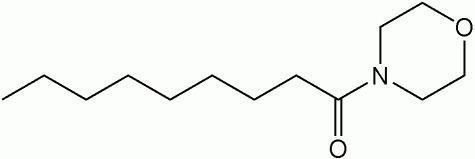Appearance Liquid Molar mass 227.34 g/mol | Formula C13H25NO2 Boiling point 310 °C | |
 | ||
4-Nonanoylmorpholine (pelargonic acid morpholide, N-nonanoylmorpholine, MPK or МПК (for морфолид пеларгоновой кислоты), or MPA) is an amide of pelargonic acid and morpholine.
Contents
Properties
4-Nonanoylmorpholine was first synthetized in 1954 by L.M. Rice, from morpholine and chloroanhydride of pelargonic acid.
It is a liquid insoluble in water and soluble in polar organic solvents (e.g. acetone, propanol, and dimethyl formamide) and fats. Its volatility is 27 mg/m3 at 20 °C and 43 mg/m3 at 35 °C.
Uses
It is a used as a solvent in lachrymatory formulations containing CR gas or CS gas. It is reported to be effective against dogs and starts being effective in concentrations of over 20–40 mg.min/m3. It is considered very safe, with high differences between effective and toxic concentrations. At one time it was reportedly used as food seasoning with no reported adverse effects. However, its effectiveness when used alone is rather low even in the highest permitted concentration, so it is almost always used in combination with CR gas or CS gas, commonly referred to as tear gas. In that combination, this blend is effective even against dogs and people under influence of alcohol or other drugs. Its effect usually lasts for 15–30 minutes.
MPK blends with CR gas or CS gas are common personal self-defense chemical agents in Russia and Ukraine, but is virtually unknown elsewhere.
4-Nonanoylmorpholine has been reported to have insect repellent properties in Aedes aegypti mosquitoes.
